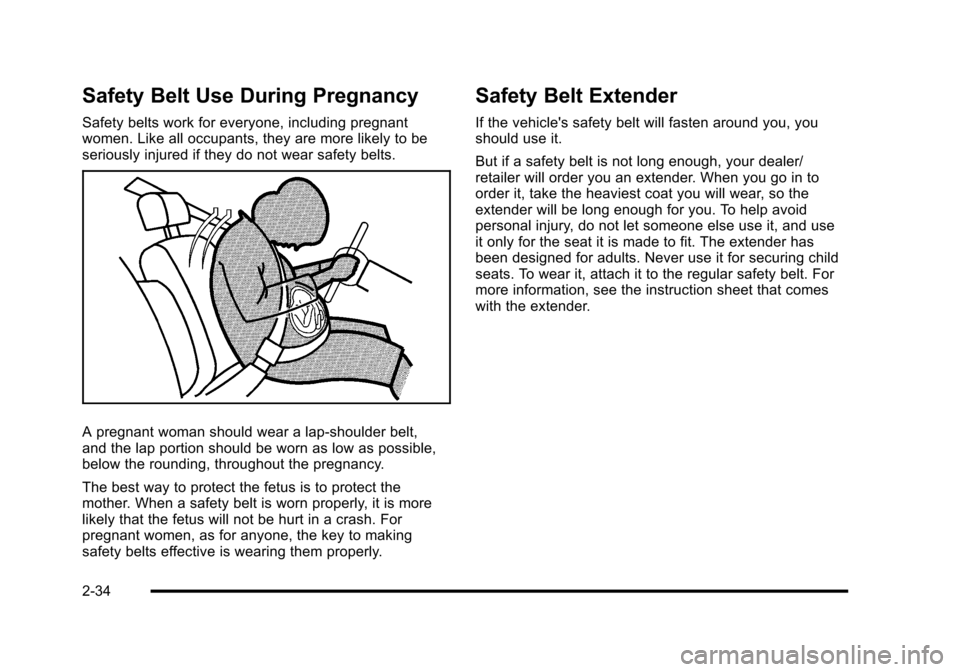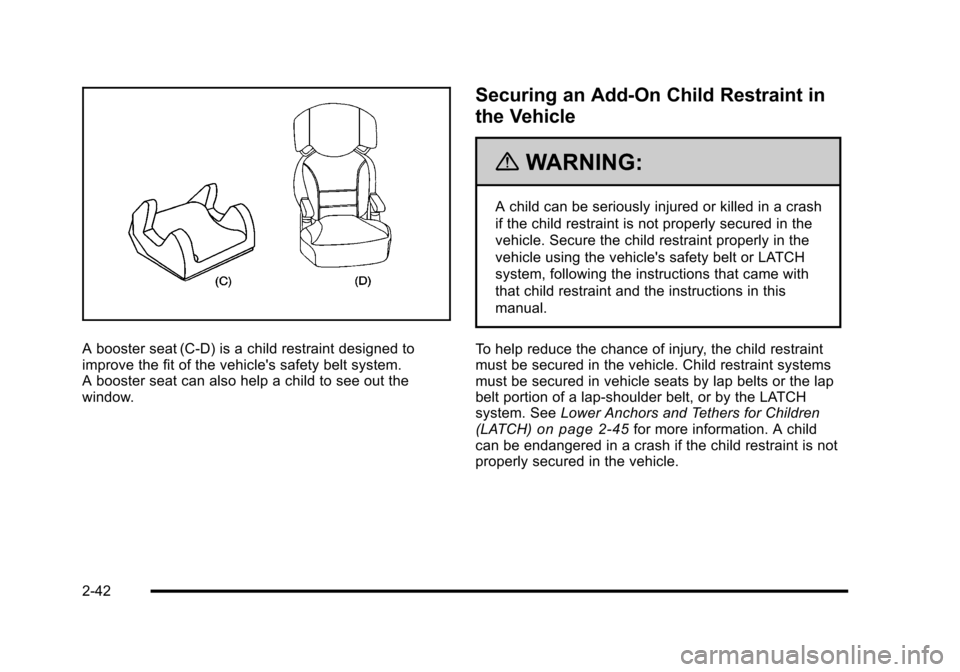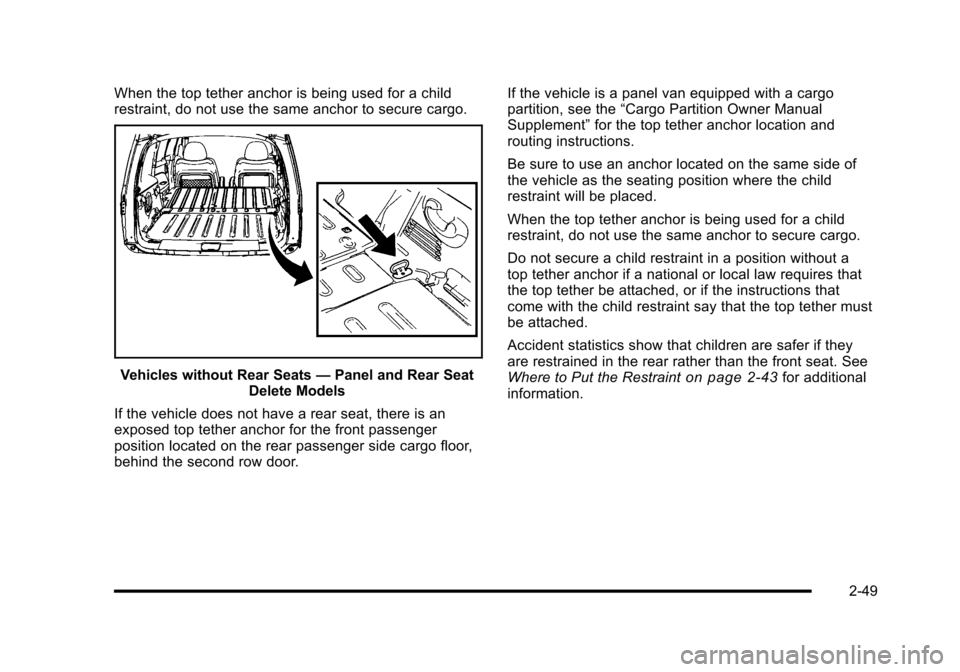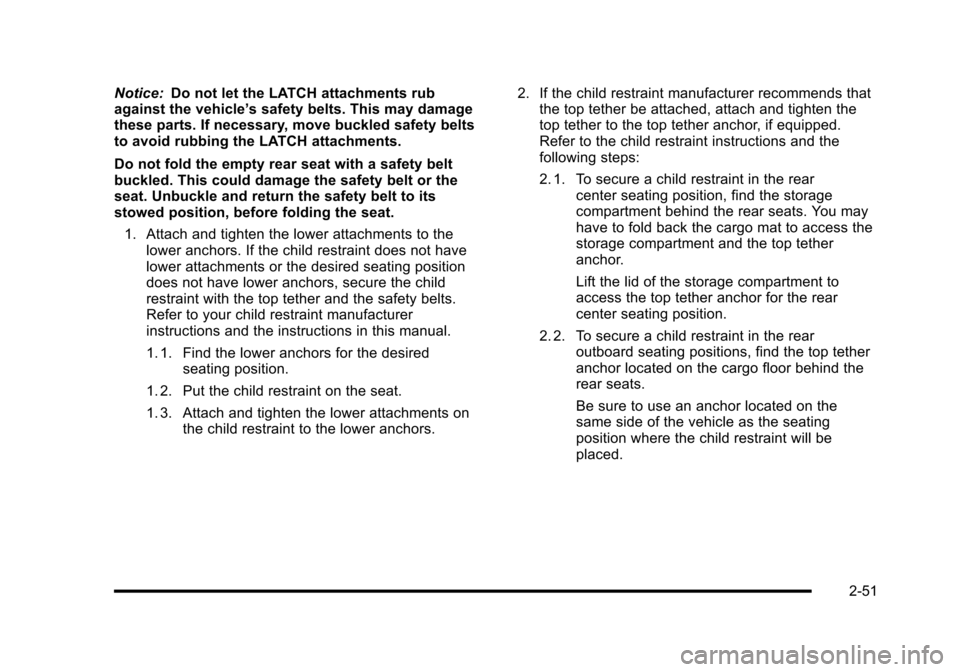2010 CHEVROLET HHR seats
[x] Cancel search: seatsPage 66 of 480

Safety Belt Use During Pregnancy
Safety belts work for everyone, including pregnant
women. Like all occupants, they are more likely to be
seriously injured if they do not wear safety belts.
A pregnant woman should wear a lap-shoulder belt,
and the lap portion should be worn as low as possible,
below the rounding, throughout the pregnancy.
The best way to protect the fetus is to protect the
mother. When a safety belt is worn properly, it is more
likely that the fetus will not be hurt in a crash. For
pregnant women, as for anyone, the key to making
safety belts effective is wearing them properly.
Safety Belt Extender
If the vehicle's safety belt will fasten around you, you
should use it.
But if a safety belt is not long enough, your dealer/
retailer will order you an extender. When you go in to
order it, take the heaviest coat you will wear, so the
extender will be long enough for you. To help avoid
personal injury, do not let someone else use it, and use
it only for the seat it is made to fit. The extender has
been designed for adults. Never use it for securing child
seats. To wear it, attach it to the regular safety belt. For
more information, see the instruction sheet that comes
with the extender.
2-34
Page 67 of 480

Child Restraints
Older Children
Older children who have outgrown booster seats should
wear the vehicle's safety belts.The manufacturer's instructions that come with the
booster seat state the weight and height limitations for
that booster. Use a booster seat with a lap-shoulder belt
until the child passes the below fit test:
.Sit all the way back on the seat. Do the knees
bend at the seat edge? If yes, continue. If no,
return to the booster seat.
.Buckle the lap-shoulder belt. Does the shoulder
belt rest on the shoulder? If yes, continue. If no, try
using the rear safety belt comfort guide. See
“Rear
Safety Belt Comfort Guides” underLap-Shoulder
Belt
on page 2‑28for more information. If the
shoulder belt still does not rest on the shoulder,
then return to the booster seat.
.Does the lap belt fit low and snug on the hips,
touching the thighs? If yes, continue. If no, return
to the booster seat.
.Can proper safety belt fit be maintained for the
length of the trip? If yes, continue. If no, return to
the booster seat.
.If you have the choice, a child should sit in a
position with a lap-shoulder belt and get the
additional restraint a shoulder belt can provide.
2-35
Page 74 of 480

A booster seat (C-D) is a child restraint designed to
improve the fit of the vehicle's safety belt system.
A booster seat can also help a child to see out the
window.
Securing an Add-On Child Restraint in
the Vehicle
{WARNING:
A child can be seriously injured or killed in a crash
if the child restraint is not properly secured in the
vehicle. Secure the child restraint properly in the
vehicle using the vehicle's safety belt or LATCH
system, following the instructions that came with
that child restraint and the instructions in this
manual.
To help reduce the chance of injury, the child restraint
must be secured in the vehicle. Child restraint systems
must be secured in vehicle seats by lap belts or the lap
belt portion of a lap-shoulder belt, or by the LATCH
system. See Lower Anchors and Tethers for Children
(LATCH)
on page 2‑45for more information. A child
can be endangered in a crash if the child restraint is not
properly secured in the vehicle.
2-42
Page 80 of 480

To assist you in locating
the top tether anchors,
this symbol is located
next to each top tether
anchor.
On vehicles equipped with rear seats, the top tether
anchor symbols for the rear outboard positions are on
the lower side of the quarter panels. The top tether
anchor symbols for the rear center position are on the
storage compartment and cargo mat, if equipped.
On vehicles without rear seats, the top tether anchor
symbol is on the lower side of the quarter on the
passenger side, behind the second row door.
If the vehicle is a panel van equipped with a cargo
partition, see the “Cargo Partition Owner Manual
Supplement” for the top tether anchor location and
routing instructions.
Vehicles with Rear Seats
The rear outboard top tether anchors are located on the
cargo floor behind the rear seats.
The rear center top tether anchor is located in a storage
compartment behind the rear seats. Lift the lid of the
storage compartment to access the anchor. You may
have to fold back the cargo mat to access the storage
compartment and the top tether anchor for the rear
center seating position.
Be sure to use an anchor located on the same side of
the vehicle as the seating position where the child
restraint will be placed.
2-48
Page 81 of 480

When the top tether anchor is being used for a child
restraint, do not use the same anchor to secure cargo.
Vehicles without Rear Seats—Panel and Rear Seat
Delete Models
If the vehicle does not have a rear seat, there is an
exposed top tether anchor for the front passenger
position located on the rear passenger side cargo floor,
behind the second row door. If the vehicle is a panel van equipped with a cargo
partition, see the
“Cargo Partition Owner Manual
Supplement” for the top tether anchor location and
routing instructions.
Be sure to use an anchor located on the same side of
the vehicle as the seating position where the child
restraint will be placed.
When the top tether anchor is being used for a child
restraint, do not use the same anchor to secure cargo.
Do not secure a child restraint in a position without a
top tether anchor if a national or local law requires that
the top tether be attached, or if the instructions that
come with the child restraint say that the top tether must
be attached.
Accident statistics show that children are safer if they
are restrained in the rear rather than the front seat. See
Where to Put the Restrainton page 2‑43for additional
information.
2-49
Page 83 of 480

Notice:Do not let the LATCH attachments rub
against the vehicle’ s safety belts. This may damage
these parts. If necessary, move buckled safety belts
to avoid rubbing the LATCH attachments.
Do not fold the empty rear seat with a safety belt
buckled. This could damage the safety belt or the
seat. Unbuckle and return the safety belt to its
stowed position, before folding the seat.
1. Attach and tighten the lower attachments to the lower anchors. If the child restraint does not have
lower attachments or the desired seating position
does not have lower anchors, secure the child
restraint with the top tether and the safety belts.
Refer to your child restraint manufacturer
instructions and the instructions in this manual.
1. 1. Find the lower anchors for the desired seating position.
1. 2. Put the child restraint on the seat.
1. 3. Attach and tighten the lower attachments on the child restraint to the lower anchors. 2. If the child restraint manufacturer recommends that
the top tether be attached, attach and tighten the
top tether to the top tether anchor, if equipped.
Refer to the child restraint instructions and the
following steps:
2. 1. To secure a child restraint in the rear
center seating position, find the storage
compartment behind the rear seats. You may
have to fold back the cargo mat to access the
storage compartment and the top tether
anchor.
Lift the lid of the storage compartment to
access the top tether anchor for the rear
center seating position.
2. 2. To secure a child restraint in the rear outboard seating positions, find the top tether
anchor located on the cargo floor behind the
rear seats.
Be sure to use an anchor located on the
same side of the vehicle as the seating
position where the child restraint will be
placed.
2-51
Page 84 of 480

2. 3. To secure a child restraint in the frontpassenger position, only if your vehicle
does not have rear seats, find the top tether
anchor located on the passenger side cargo
floor behind the second row door.
Be sure to use an anchor located on the
same side of the vehicle as the seating
position where the child restraint will be
placed.
2. 4. If the vehicle is a panel van equipped with a cargo partition, see the “Cargo Partition
Owner Manual Supplement” for the top tether
anchor location and routing instructions.
2. 5. If the position you are using has an adjustable headrest or head restraint,
raise it. 2. 6. Route, attach, and tighten the top tether
according to your child restraint instructions
and the following instructions:
If the position you are
using does not have a
headrest or head restraint
and you are using a
single tether, route the
tether over the seatback.
If the position you are
using does not have a
headrest or head restraint
and you are using a dual
tether, route the tether
over the seatback.
2-52
Page 109 of 480

Adding Equipment to Your
Airbag-Equipped Vehicle
Q: Is there anything I might add to or change aboutthe vehicle that could keep the airbags from
working properly?
A: Yes. If you add things that change the vehicle's
frame, bumper system, height, front end or side
sheet metal, they may keep the airbag system from
working properly. Changing or moving any parts of
the front seats, safety belts, the airbag sensing and
diagnostic module, steering wheel, instrument panel,
roof-rail airbag modules, ceiling headliner or pillar
garnish trim, front sensors, side impact sensors,
rollover sensor module, or airbag wiring can affect
the operation of the airbag system.
In addition, the vehicle may have a passenger
sensing system for the right front passenger
position, which includes sensors that are part of the
passenger seat. The passenger sensing system
may not operate properly if the original seat trim is
replaced with non-GM covers, upholstery or trim,
or with GM covers, upholstery or trim designed for a
different vehicle. Any object, such as an aftermarket
seat heater or a comfort enhancing pad or device,
installed under or on top of the seat fabric, could
also interfere with the operation of the passenger sensing system. This could either prevent proper
deployment of the passenger airbag(s) or prevent
the passenger sensing system from properly turning
off the passenger airbag(s). See
Passenger Sensing
Systemon page 2‑70.
If you have questions, call Customer Assistance.
The phone numbers and addresses for Customer
Assistance are in Step Two of the Customer
Satisfaction Procedure in this manual. See
Customer Satisfaction Procedure on page 8‑2.
If the vehicle has rollover roof-rail airbags, see
Different Size Tires and Wheels
on page 6‑74for
additional important information.
Q: Because I have a disability, I have to get my vehicle modified. How can I find out whether this
will affect my airbag system?
A: If you have questions, call Customer Assistance.
The phone numbers and addresses for Customer
Assistance are in Step Two of the Customer
Satisfaction Procedure in this manual. See
Customer Satisfaction Procedure on page 8‑2.
In addition, your dealer/retailer and the service manual
have information about the location of the airbag
sensors, sensing and diagnostic module and airbag
wiring.
2-77